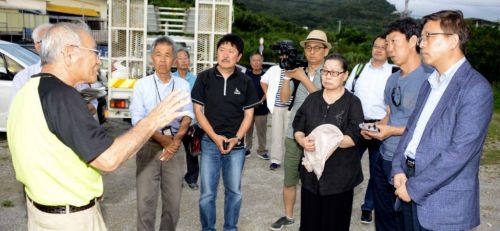Japanese and South Korean groups to perform joint survey of Motobu burial site

Remains collection volunteer group “Gamafuya” representative Takamatsu Gushiken (second from left) and Hija Lee (fourth from right) listen to an explanation by Hideo Nakamura (left), who lives across from the spot where remains were buried on June 21 in Kenken, Motobu.
June 22, 2017 Ryukyu Shimpo
By Teppei Ikeda
In light of a Ryukyu Shimpo report revealing that fourteen military personnel and others, including Koreans, who died in an air strike by the U.S. military on a Japanese military transport ship were buried in Kenken, Motobu, members of the Battle of Okinawa remains collection volunteer group “Gamafuya”, members of a civic group calling for reparations for Koreans who were forcibly conscripted, and Motobu locals visited the burial site on June 21. Gamafuya representative Takamatsu Gushiken announced that he intends to survey the buried remains in cooperation with volunteers from South Korea and from the local area as a “Japan-South Korea amity project”. According to Masao Gabe, a relative of the landowner of the site and an emeritus professor at Yamanashi Gakuin University, the landowner plans to cooperate in the survey, and the Japanese and Korean organizations will soon begin discussions on the specifics of the survey.
A similar example can be found in the case of Shumarinai, Horokanai, Hokkaido. In 1997, a group comprising primarily youth participated in a group comprising primarily youth participated in a Japan-South Korea amity project to recover the remains of victims who were forcibly brought over as laborers from the Korean peninsula during the war and lost their lives doing dam construction, road work and other labor. In Motobu, Japanese and South Korean youth, support groups, and local people plan to use the Shumarinai case as an example and cooperate in recovery of the remains.
Gushiken explained the significance of a joint Japan-South Korea survey, saying, “We want to do whatever we can to return the remains of the deceased. Even if we don’t find any remains, it is important to endeavor to get closer to those who lost their lives. I hope we can follow the example of Japan-South Korea cooperation in Hokkaido to collect remains and thereby work to create a peaceful future.”
Twenty people participated in the visit on June 21, and local residents talked about the state of the land at the time the deceased were buried. According to the residents, the land was used by Professor Gabe’s father, also named Masao Gabe, for agriculture at the time of the burial. They explained that the land has since been elevated by roughly two meters.
Hija Lee, age 74, traveled to Okinawa from Korea. At the burial site, she spoke to the deceased, saying, “I have made you wait a long time.” She made an offering of liquor that she had brought from Korea and prayed for their happiness in the next world. “It pains me that this was not made public until it was revealed in the news,” said Lee. “I am grateful to the local people [of Motobu], and I want to work to bring the remains back home.”
The Japanese military transport ship “Hikosan Maru” was the target of U.S. military gunfire and aerial bombing on January 22, 1945.
(English translation by T&CT and Sandi Aritza)
Previous Article:Tourism revenue for Okinawa reaches 660 billion yen, breaking record four years in a row
Next Article:Service held for war dead of former Ourasaki Camp, where 400 bones remain unrecovered
[Similar Articles]
- “Association for Returning Remains to their Homeland” established for joint Japan-South Korea collection of Battle of Okinawa remains in Kenken, Motobu, Okinawa
- Participants from Japan, South Korea, and Taiwan search for remains of Battle of Okinawa victims in Kenken, Motobu, wish for peace in East Asia
- Memorial ceremony held for Koreans mobilized during war, exhumation in May
- Amami’s oldest rock shelter tomb identified as 11-12th-century sakudamata, age determined by remains discovered there
- Okinawan and South Korean citizens hold peace symposium urging withdrawal of US troops
 Webcam(Kokusai Street)
Webcam(Kokusai Street)


